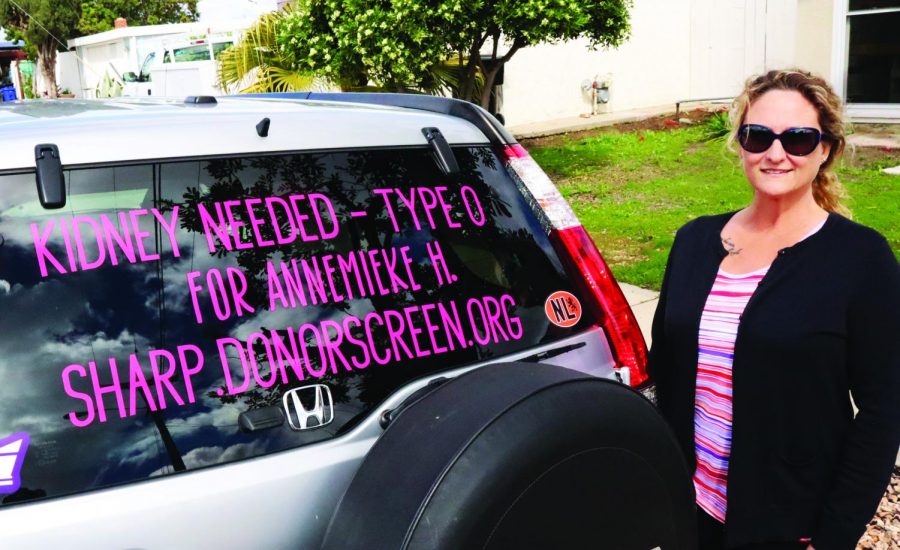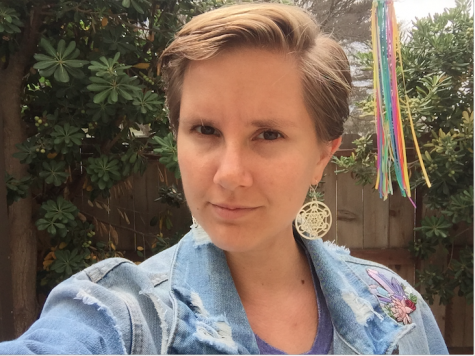Mesa College student and single mother Annemieke Hutchinson addressed her friends and family in a February 2018 letter on Facebook, asking a difficult question: are you willing to donate a kidney?
Hutchinson had been diagnosed some years earlier with the same illness her mother had — Polycystic Kidney Disease. But after a while of monitoring the condition, Hutchinson’s health began to rapidly decline.
“This may be the hardest thing I will ever have to endure or ask in my life,” the Facebook letter began. “Writing this letter is scary and makes things very real.”
As of 2019, her glomerular filtration rate (GFR), which is a measure of overall renal function, is 13 percent — only a few points above the rate that the Polycystic Kidney Disease Foundation cites as critically requiring dialysis or a transplant for the patient’s survival.
Hutchinson has reached stage five, known as End Stage Renal Disease or ESRD. Now, she’s doubling down on locating a donor as an alternative to starting dialysis. “I’m hoping to get a kidney first,” Hutchinson said in an interview, adding, “I have friends who are getting tested.”
The process of transitioning to dialysis, Hutchinson said, is lengthy. To receive dialysis in the hospital, patients must have a surgical implant placed in the forearm. The implant must have time to heal before dialysis treatment can even begin. It is a process Hutchinson indicated she would like to avoid.
There are two ways to receive a kidney transplant: from a hospital transplant list, through a deceased organ donor; or directly from a living donor.
Organ waitlists come from deceased organ donors, with kidneys specifically from organ donors who died from brain death, in order to assure the health of the kidneys themselves.
According to the National Kidney Foundation’s website, the median wait time for patients on the list for their first kidney transplant is 3.6 years. On average, the site adds, 13 people die every day waiting for a kidney on the list.
According to the website for University of San Francisco’s Department of Surgery, screening living donors for a match requires blood type testing, tissue type testing, and antibody cross-match testing are a few of the primary procedures for determining if a donor’s kidney can be used by a patient.
UCSF’s Transplant website says that a living donor “must be in excellent health, well informed about transplantation, and able to give informed consent.” It clarifies, “Any healthy person can donate a kidney safely.”
Hutchinson said that the benefit of locating her own kidney donor is bypassing the wait list. She acknowledged that finding a living match can be difficult — but then brought up kidney transplant chains. “You can’t even say really you can’t (donate) because we’re not the same blood type, because you can,” she said.
Called the Never Ending Altruistic Donor (NEAD) Chain on National Kidney Center’s website, transplant chains start with a single donor who gives up a kidney without an identified match. “Each living donor in this system gives to a stranger, and the chain of donors is kept as long as possible,” NEAD’s webpage says.
“I think that if you are in good health, you think about wanting to do something like this — it’s a noble offer,” Hutchinson said. She added, “you might not even be compatible, but at least you’re trying, you’re trying to give hope to others, and it’s nice to know that people are there to help you and want to help you live.”
Hutchinson talked about her experience with living with PKD. “Don’t judge a book by it’s cover,” she said, referring to her misleading outward appearance of good health.
Finding kidney-safe food and maintaining her activity level were some of the biggest challenges she faced. “It’s very important to take control of your own health — of your own future,” she said.
To regulate her weight and optimize herself for a potential transplant, she must find ways to exercise despite the symptoms of renal failure, as well as despite the primary lymphedema in her leg.
Hutchinson said of coping with the diagnosis, “You know you have something, and then, until you really get into it you don’t know how bad it is, so it’s the scary unknown.”
But she said that once she got tested, there was no avoiding the diagnosis — “it’s real, and it’s in your face, and now you can’t hide from it,” she said.
All the same, she stressed the importance for people with kidney disease to keep seeking options. “You find a way,” she said. “No is not an answer.”
Hutchinson also stressed how vital it is to have a support system — someone to be there for appointments, to take notes, and to help process the reality of the situation. She added that “you want somebody there to kind of be your voice, in a way, to advocate for you, and maybe ask other people (about donating) for you.”
To register as a potential donor for Hutchinson, visit Sharp.DonorScreen.org. Hutchinson can also be reached via email, annemiekef@hotmail.com, or under “A Kidney for Annemieke” on both Facebook and GoFundMe.


